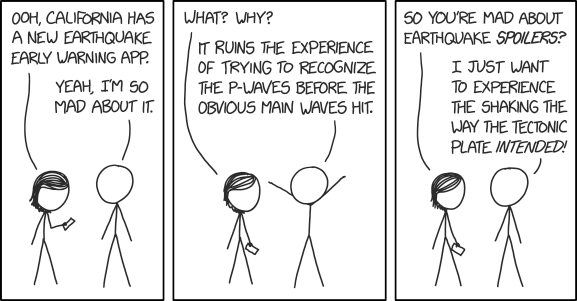We still have 15 explanations we need to complete. All incomplete explanations are here.
Help us finish the index of What if? articles! We need to clean up & add the new YouTube videos!
2219: Earthquake Early Warnings
Explanation
| |
This explanation may be incomplete or incorrect: Created by a SPOILED EARTHQUAKE. Please mention here why this explanation isn't complete. Do NOT delete this tag too soon. If you can address this issue, please edit the page! Thanks. |
A week before this comic, on October 17th, California introduced an earthquake warning system in the form of an app for smartphones called MyShake. The system works through a network of sensors across the state that can detect P-waves from an earthquake, which move faster than the S-waves, which cause most of the damage. Because of this difference in speed, the network can send warnings through the app about 5-20 seconds before major shaking occurs, enough time for people to take cover under tables, run outside, etc. The farther you are away from the earthquake, the more warning time you have.
In the comic Megan talks about the app, suggesting how cool it is, but Cueball is upset. He seems to think that prediction of the earthquake coming is like a spoiler that ruins the experience of how an earthquake should be experienced. Apparently he tries to recognize the P-waves before the S-waves hit; this is a challenge, as people cannot feel the P-waves as easily as the S-waves.
He also personifies the tectonic plates (whose shifting positions causes the quake), saying that we should all feel the shaking the way the tectonic plate intended.
Earthquake warnings, on a smartphone but not as an app, were the topic of 723: Seismic Waves, and shortly before that a protip for an alternative seismograph was mentioned in 711: Seismograph.
In the title text Cueball mentions that he was fired from the National Weather Service five minutes after they hired him because the first thing he did was to rename tornado warnings as tornado spoiler alerts. A spoiler alert is something used, for instance, when talking about a plot twist of a new movie, so that people who haven't seen the movie can avoid learning important details that would spoil the experience of seeing the movie. Cueball seems to genuinely wish to be surprised by these potentially lethal phenomena for which just minutes of warning may make the difference between life and death.
An app for warning about tornadoes was the topic of 937: TornadoGuard. Warnings in general by the NWS were the subject in 2179: NWS Warnings. Tornadoes was mentioned here, as was volcanoes and Tsunamis, the later often caused by Earthquakes, but quakes were not mentioned.
Transcript
- [Megan is looking at her phone while standing next to Cueball]
- Megan: Ooh, California has a new earthquake early warning app.
- Cueball: Yeah, I'm so mad about it.
- [Megan puts her phone down and looks at Cueball who throws his arms up in the air.]
- Megan: What, why?
- Cueball: It ruins the experience of trying to recognize the p-waves before the obvious main waves hit.
- [Megan still looks at Cueball who has taken his arms down.]
- Megan: So you're mad about earthquake spoilers?
- Cueball: I just want to experience the shaking the way the tectonic plate intended!
Discussion
Earthquake early warning works mostly because the sensors are closer to the epicenter than the victims. The warning is transmitted at the speed of light (radio in this case) which is much faster than the earthquake waves. So the warning arrives first at a distant victim. The difference in speed of the various earthquake waves has little to do with it. The interpretation of cueballs remarks is over reaching.162.158.62.135 20:53, 23 October 2019 (UTC)
- Wikipedia disagree with you saying that you might get a warning from a few seconds to more than a minute just based on P-waves which move faster than S-waves. Have added this link to the description. --Kynde (talk) 21:26, 23 October 2019 (UTC)
Anyone else think this drawing is weirdly grey compared to other recent ones? - Anonymous (how edgy!) 22:21 23 October 2019 (UTC)
That's why I don't use the bun spoiler app. --172.68.245.193 23:16, 23 October 2019 (UTC)
(Dark humo(u)r...) Would a Mass Shooting alert app involve a "trigger warning"? (/Dark whatever). 162.158.158.127 18:21, 25 October 2019 (UTC)
Surface waves cause nearly all of the damage of an earthquake, not s-waves (shear waves). This should be updated. P-waves, or primary waves, arrive first and are compression waves which can also be used to determine the alignment and type of earthquake, such as a normal or reverse fault. S-waves, or secondary waves, follow the p-waves and are shear waves which do cause more damage than p-waves, but they cause far less damage than surface waves, such as Rayleigh and Love waves. Surface waves arrive last, but cause by far the most damage. Randall talks about "p-waves before the obvious main wave", which is likely a reference to p-waves vs. surface waves.

